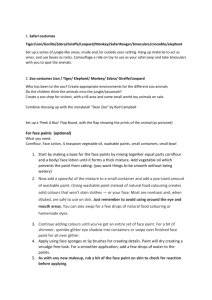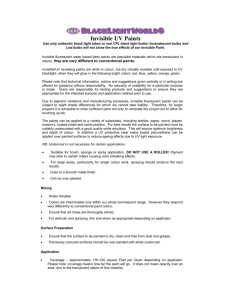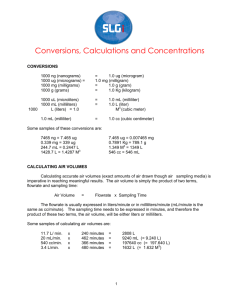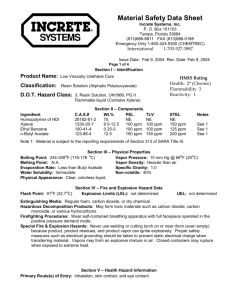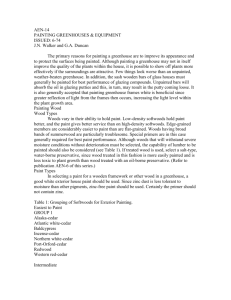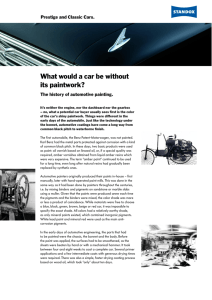Case Study 1 Paint Manufacturing
advertisement
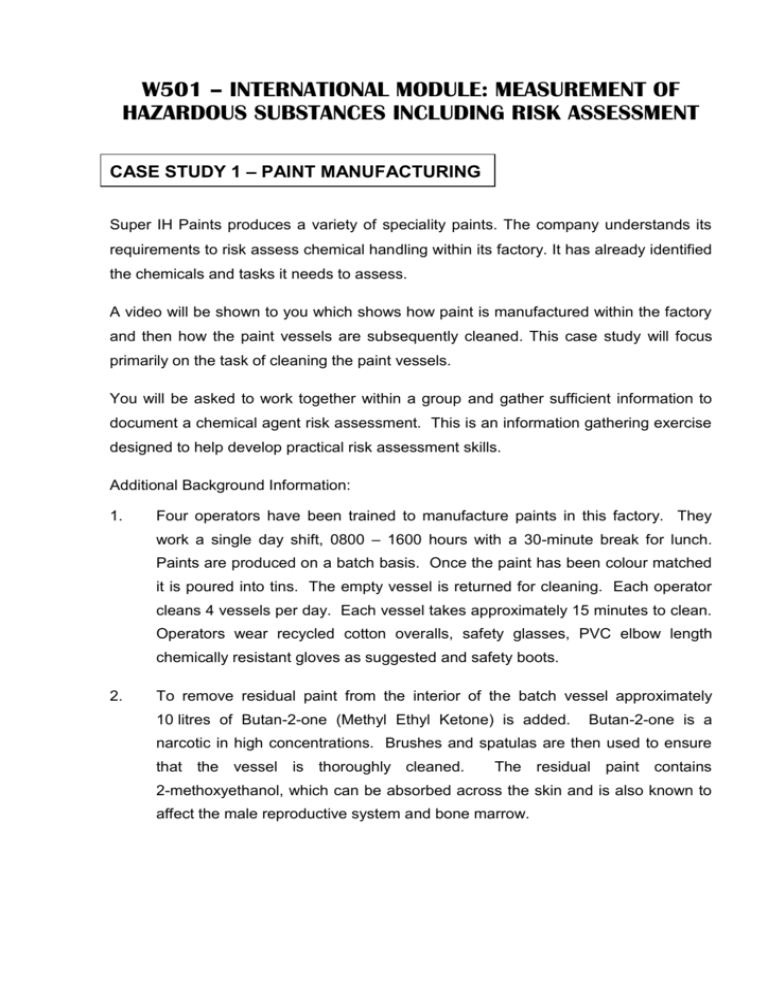
W501 – INTERNATIONAL MODULE: MEASUREMENT OF HAZARDOUS SUBSTANCES INCLUDING RISK ASSESSMENT CASE STUDY 1 – PAINT MANUFACTURING Super IH Paints produces a variety of speciality paints. The company understands its requirements to risk assess chemical handling within its factory. It has already identified the chemicals and tasks it needs to assess. A video will be shown to you which shows how paint is manufactured within the factory and then how the paint vessels are subsequently cleaned. This case study will focus primarily on the task of cleaning the paint vessels. You will be asked to work together within a group and gather sufficient information to document a chemical agent risk assessment. This is an information gathering exercise designed to help develop practical risk assessment skills. Additional Background Information: 1. Four operators have been trained to manufacture paints in this factory. They work a single day shift, 0800 – 1600 hours with a 30-minute break for lunch. Paints are produced on a batch basis. Once the paint has been colour matched it is poured into tins. The empty vessel is returned for cleaning. Each operator cleans 4 vessels per day. Each vessel takes approximately 15 minutes to clean. Operators wear recycled cotton overalls, safety glasses, PVC elbow length chemically resistant gloves as suggested and safety boots. 2. To remove residual paint from the interior of the batch vessel approximately 10 litres of Butan-2-one (Methyl Ethyl Ketone) is added. Butan-2-one is a narcotic in high concentrations. Brushes and spatulas are then used to ensure that the vessel is thoroughly cleaned. The residual paint contains 2-methoxyethanol, which can be absorbed across the skin and is also known to affect the male reproductive system and bone marrow. 2. 3. Personal monitoring has been performed and analysis of the samples obtained gave Butan-2-one 8-hour time-weighted average concentrations in the range 100 – 300 ppm. 2-methoxyethanol 8-hour TWA concentrations were all less than 1 ppm (Occupational Hygiene Report, ‘Assessment of exposure to vapour and noise’, Ref: KJ0087K, 01/09/05). The operators performing this task commented that they often experienced light-headedness, headache and nausea at the end of the working day. 4. Procedures describing how this task should be performed are not available. However, local exhaust ventilation units are uniquely identified, maintained at regular intervals and are subject to a thorough examination and test every 14 months. The maintenance department undertakes weekly visual inspections of these units. Confined space entries are controlled through a permit to work system. Regular safety walkthroughs involving safety discussions with staff are carried out. 5. Process operators have received training on the harmful effects of the materials used and on the correct application of the control measures that have been provided. 6. Occupational exposure limits, risk phrases and boiling points for butan-2-one and 2-methoxyethanol are as follows: - Butan-2-one (methyl ethyl ketone) – 200 ppm 8 hour TWA and 300ppm 15 minute STEL, Narcotic in high concentrations. Absorbs through skin. Risk phrases: 11, 36, 66, 67, Boiling point: 80°C. - Paint (2-methoxy ethanol) – 5 ppm 8 hour TWA, Long-term effects on male reproductive organs. Absorbs through skin, Risk phrases: 60, 61,10, 20/21/22, Boiling point: 125°C. - Risk Phrases R10 - Flammable R11 - Highly flammable R20/21/22 - Harmful by inhalation, in contact with the skin and if swallowed 3. 7. R36 - Irritating to eyes R60 - May impair fertility R61 - May cause harm to the unborn child R66 - Repeated exposure may cause skin dryness or cracking R67 - Vapours may cause drowsiness and dizziness Emergency response, in this case loss of containment and subsequent spillage, has been well addressed by the company. Detailed emergency procedures are available and an emergency exercise conducted annually. Spill kits and personal protective equipment (including breathing apparatus) are available together with a separate first aid room. Note: This case study is based on a range of archive materials adapted to create a case study for student use. It does not represent any particular company or situation past or present. Any resemblance to current people, organisations or companies is coincidental.
![[Agency] recognizes the hazards of lead](http://s3.studylib.net/store/data/007301017_1-adfa0391c2b089b3fd379ee34c4ce940-300x300.png)



